FC Cincinnati joined the MLS in 2019 and took quite a while to settle down. The club, who were founded in 2015, were handed the wooden spoon three seasons in a row from 2019-2021 before seeing a massive improvement during the 2022 campaign, finishing fifth but eventually losing out to the Philadelphia Union in the Eastern Conference semi-finals.
The instigator for the club’s success was the arrival of Pat Noonan, the former USMNT and Union assistant coach. In his first season as a professional head coach in 2022, Noonan took the Orange and Blue from being the whipping boys in the East to a handful for any side.
Fast forward to this season, Cincinnati are top of the Eastern Conference, on course to win the Supporters’ Shield. In fact, just five teams in MLS history have ever picked up 33 points after 14 games. Noonan’s men were one. All the rest went on to win the Supporters’ Shield. No pressure.
The improvement under Noonan has been wonderful, but perhaps nobody expected it to be this impressive. But what makes Cincinnati’s feat more intriguing is that they have averaged less than 50 percent possession which has become increasingly uncommon in the modern game.
So, let’s take a look at why Noonan’s Cincinnati are killing it this season. This tactical analysis piece will analyse Cincinnati’s tactics this season, looking at why pragmatism still has a part to play in this possession-oriented sport.
Noonan’s preferred shape
For the most part, you need possession to score goals but in theory, a team can have one percent of the ball and still win a game one nil. There is no guarantee that dominating the ball leads to more success on the pitch.
Since Pep Guardiola’s positional play revolution at Barcelona all those years ago, umpteen coaches have attempted to replicate this style, using their own vision to bring it to life. This has been particularly apparent in the aftermath of Pep’s arrival in English football.
Teams at the elite level may win games of football with less possession than their opponents but it’s becoming increasingly uncommon for this to translate to winning titles anymore. The days of Rafa Benítez and José Mourinho’s pragmatistic methods seem long gone.
However, Cincinnati are proving to be contrarian to this current trend. Pat Noonan’s side are averaging 46.5 percent of the ball per game, the seventh-lowest average across both MLS Conferences. But this doesn’t necessarily mean that the Garys are a defensive, counterattacking side – just that Noonan is content with allowing the opposition to have the ball for the majority of the game.
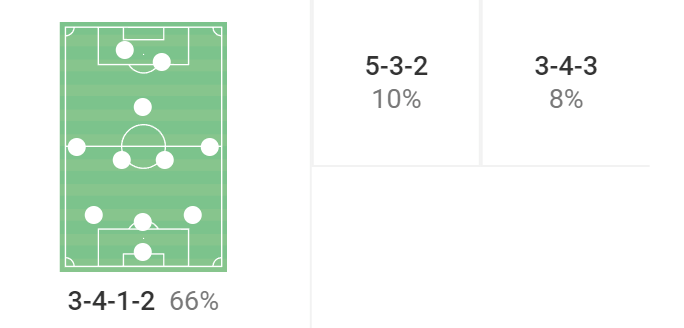
Firstly, to understand how Cincinnati play, it’s important to note the side’s structure in matches. Noonan has preferred to deploy a 3-4-1-2 in games, although the 5-3-2 and 3-4-3 have also been seen. Nonetheless, Cincinnati are yet to attempt a back-four formation this season, and understandably so. The team have lost just once this season so it would be senseless for the head coach to change it up.
The 3-5-2/5-3-2 is primarily used when the Orange and Blue are leading in games and need to see the result out, offering an extra man in midfield to protect the backline.
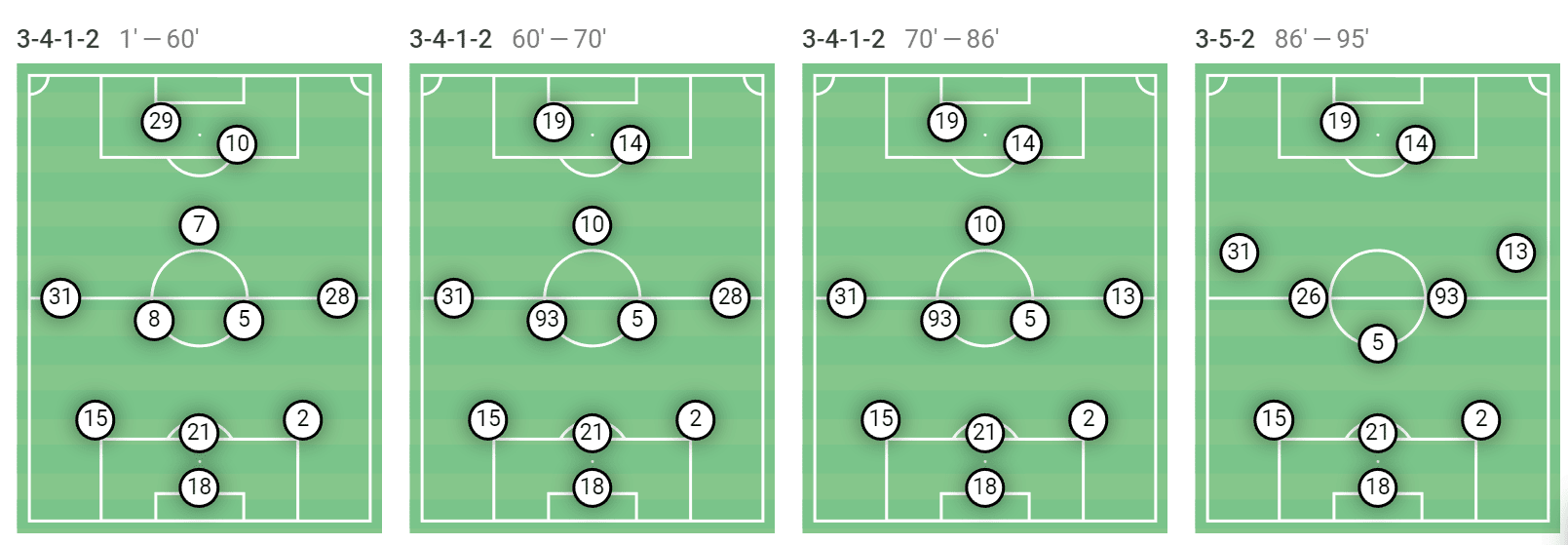
In Cincinnati’s recent 1-0 win over the Chicago Fire, Noonan’s men scored late on through their playmaking number ‘10’ Luciano Acosta. Within minutes, Acosta was replaced by the more defensively-minded Malik Pinto as Cincinnati saw the game out.
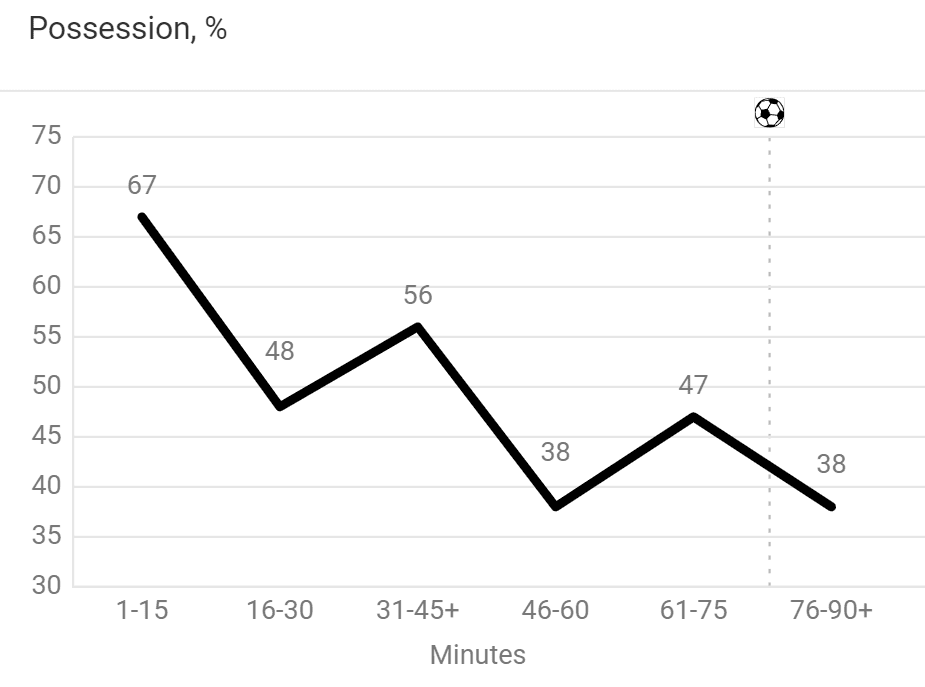
The team’s possession dropped massively down to 38 percent during the last quarter of an hour as FC Cincinnati looked to sit back and protect the 1-0 lead. The introduction of Pinto into the midfield was an astute change by Noonan in this respect.
Risky mid-block
Cincinnati mainly defend in a mid-block. The base structure is a 3-4-1-2, but the mid-block shape is a 5-2-1-2 as the wingbacks drop into the backline to defend against an overload as three men are easily overloaded at the back, particularly if the opposition’s fullbacks or wingbacks push high.
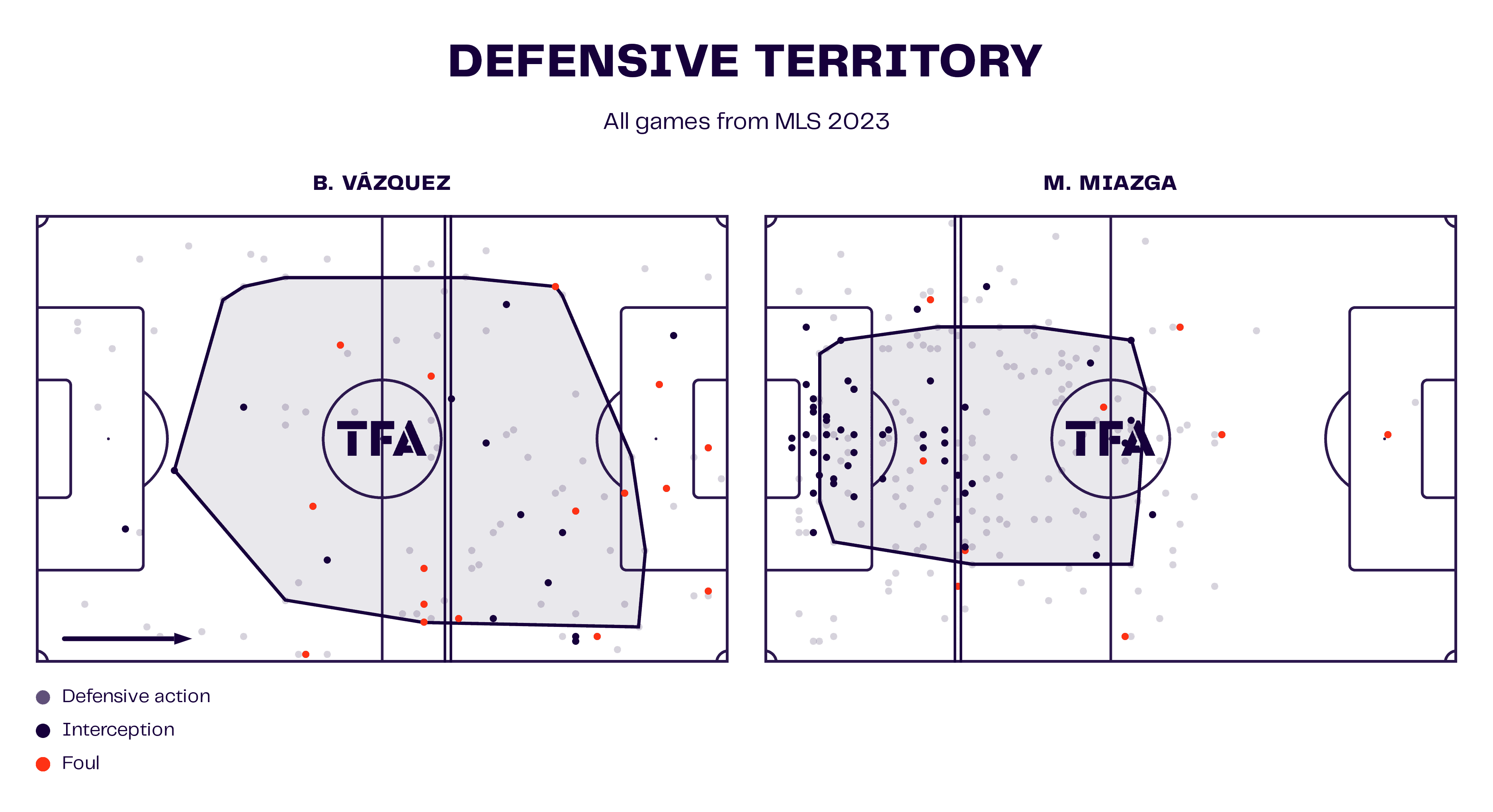
From these defensive territory maps, we can see the average defensive height for the team. Brandon Vázquez, who is typically employed in a front two, generally engages with the opponent just above the centre circle. Meanwhile, central centre-back Matt Miazga’s average defensive line height is quite deep.
Putting these lines together, we get a decent representation of Cincinnati’s block height out of possession.
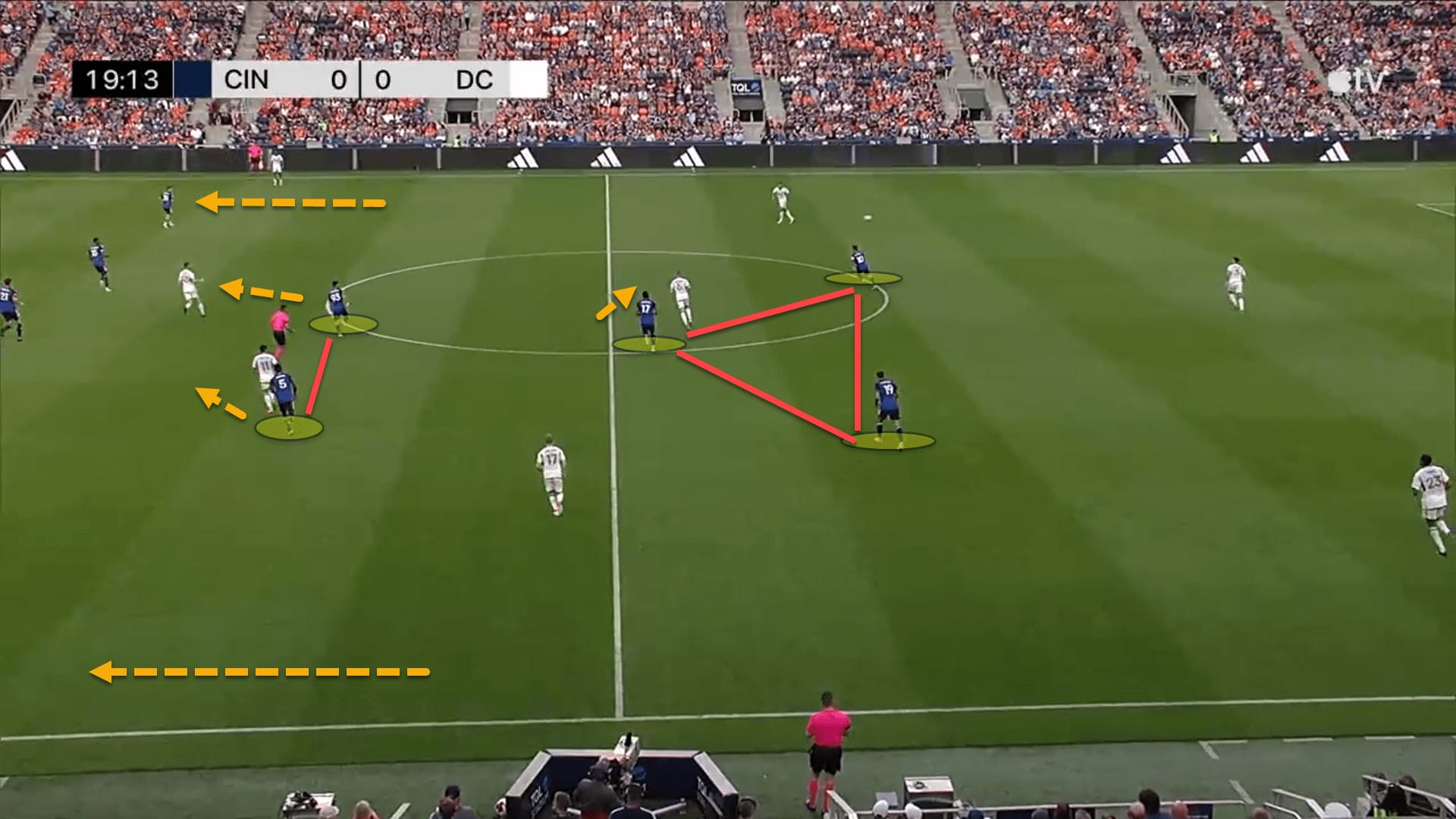
But here is a look at the side’s mid-block in-game. The first line of pressure blocks access through the centre of the pitch while the number ‘10’ sits on the deepest opposition midfielder. It is the job of the double-pivot to protect the space in front of the backline, picking up any attackers that drop into this area while also shifting from side to side.
When defending in a 5-3-2, the roles of the midfield look a little different. Noonan instructs his forwards to press the opposition’s backline while the double-pivot go man-for-man against their opposite numbers.
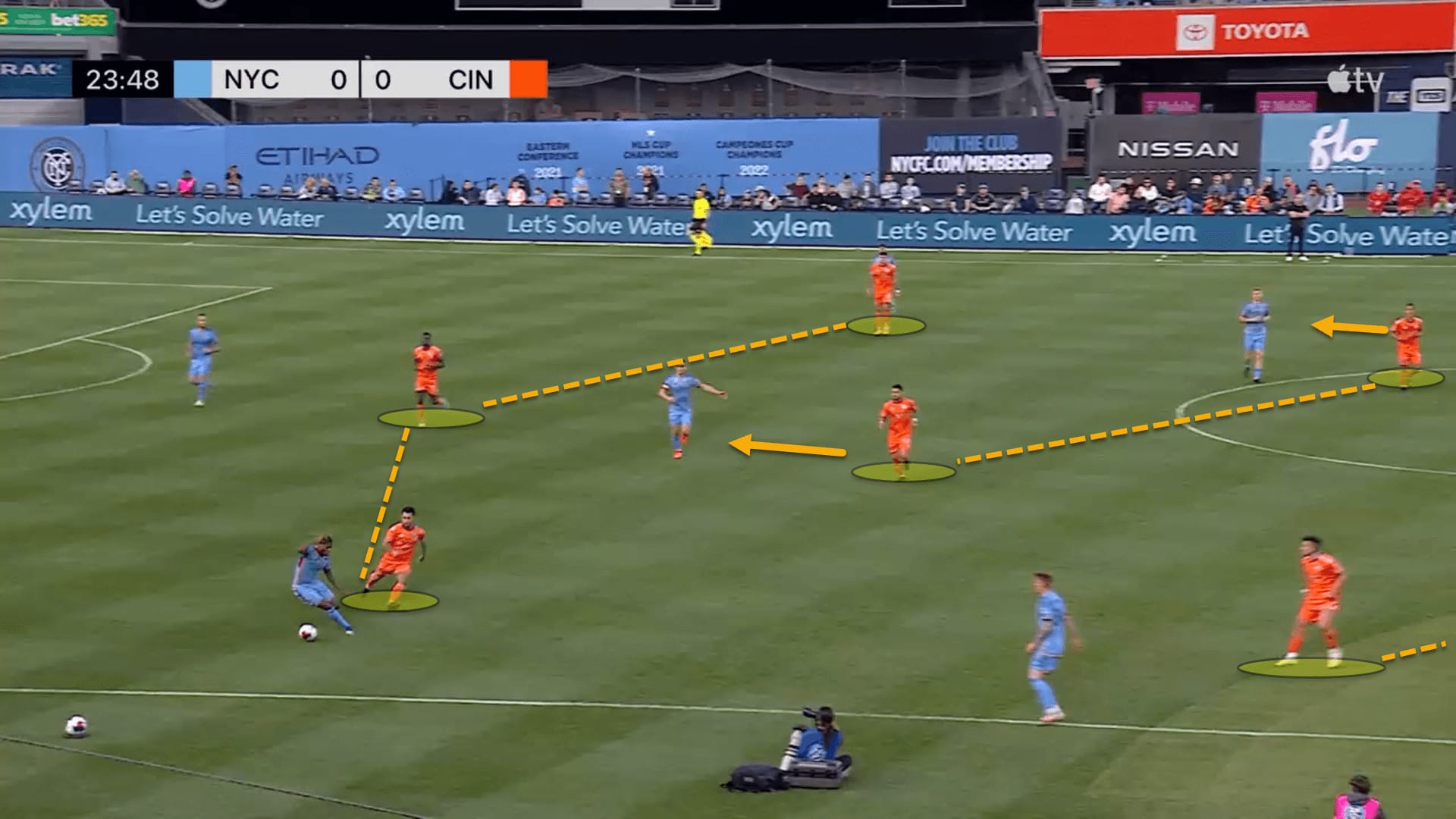
Cincinnati have been having a few issues further down the pitch, though. As the Garys don’t average a lot of possession, there is a tendency for the team to counterattack in games, particularly against more ball-dominant teams.
When Noonan’s side regain possession of the ball, the wingbacks advance quickly to provide width in transition alongside the front three. The midfielders normally stay back to ensure that Cincinnati have a five-up, five-back policy, giving the team a nice balance.
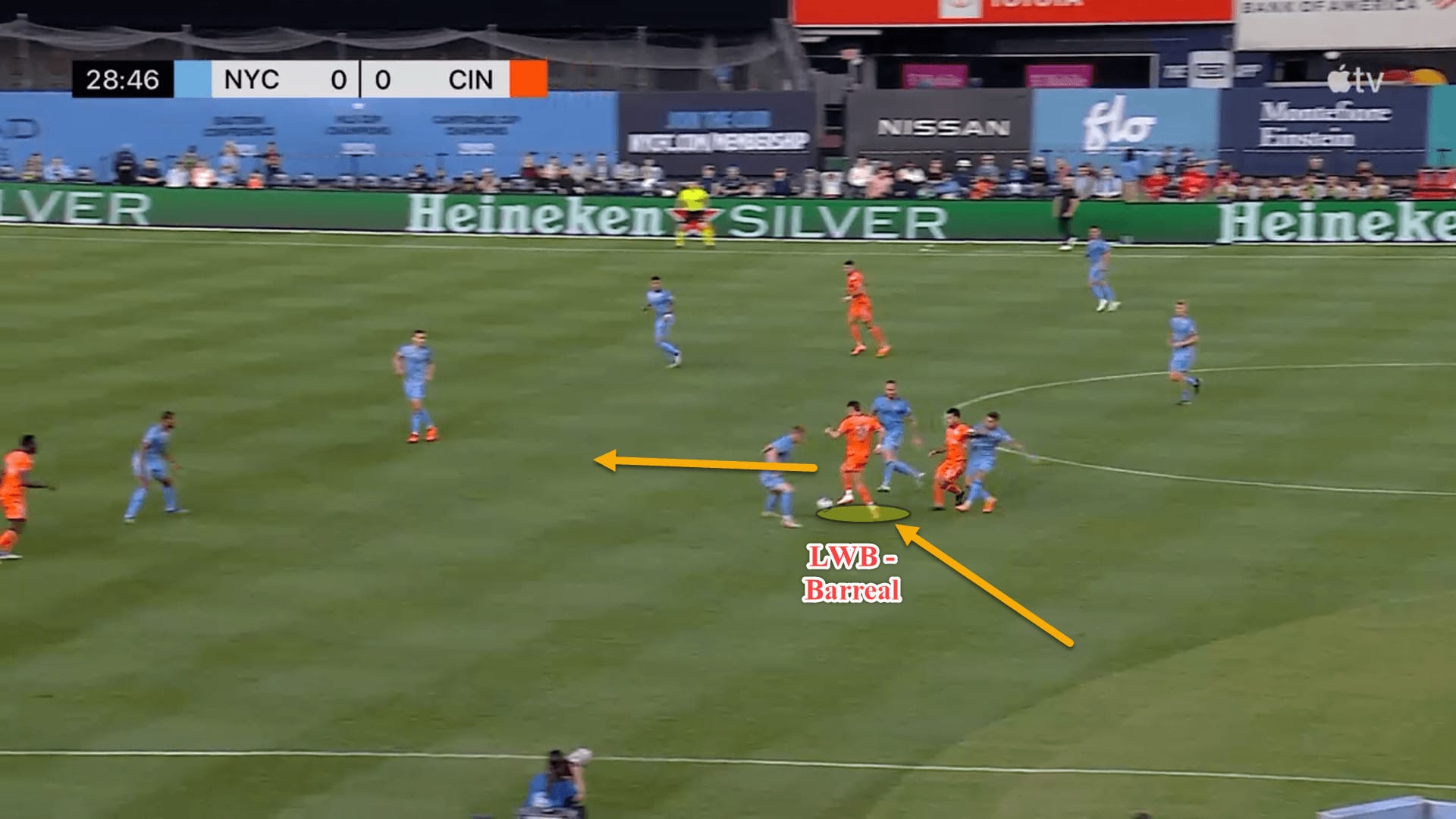
Here, left wingback Álvaro Barreal was driving forward with the ball on the counterattack. However, as he was so high and out of position, the defender was late to recover his post beside the left centre-back.
New York City FC reclaimed the ball, went up the other end and overloaded the left central defender Ian Murphy at the back-post as Barreal didn’t return quickly enough.
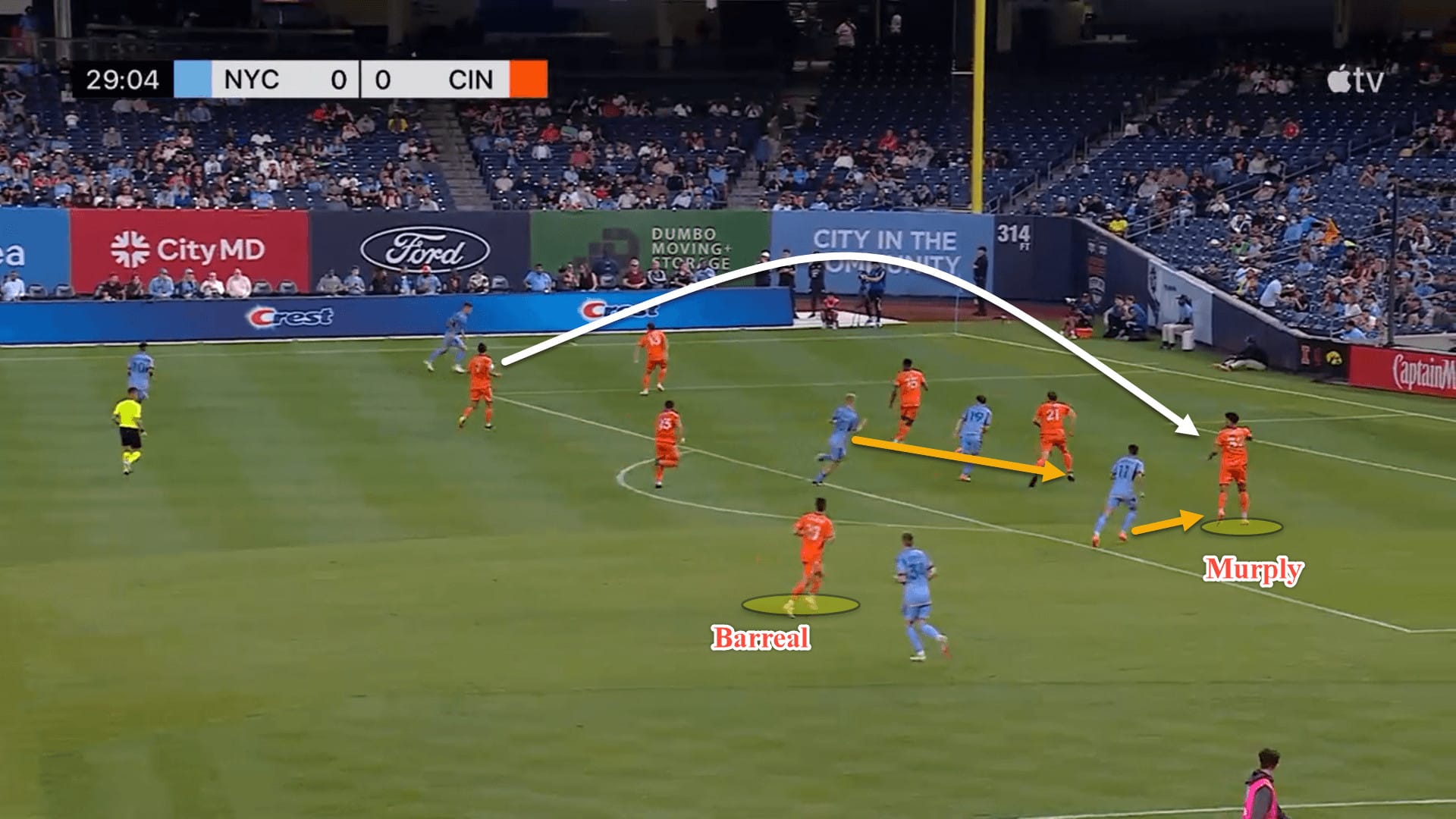
The cross was tucked away beautifully by Gabriel Pereira but it all came from Noonan taking a risk by allowing the wingbacks to get forward in transition, leaving the centre-backs exposed. Fortunately, the goal was ruled out for a foul in the build-up but the warning signs were there.
Cincinnati have been suffering from another transitional issue too. When defending in a low block, as they so often do, Noonan wants his front three to stay higher up the pitch, offering the team the ability to break quickly by playing forward once the ball is regained. This means that the Orange and Blue usually defend with a block of seven in the final third of two sitting midfielders and a back five.
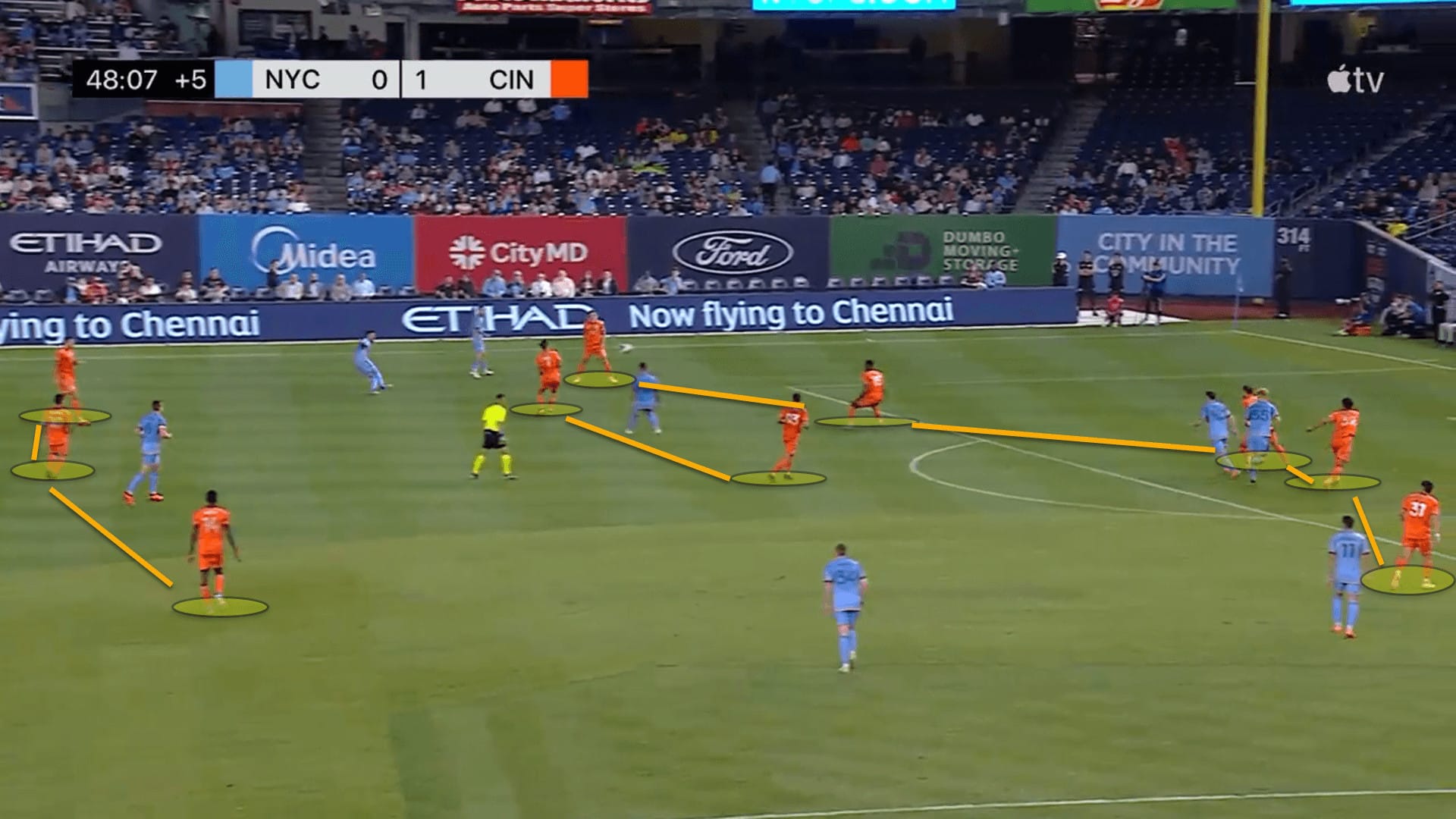
Here, we can see this defensive low block in action. The three forwards are staying higher, waiting for the ball to be won back before pouncing forward on the break.
But having this lack of defensive cover for the midfield duo leaves them quite exposed and with a lot of ground to cover, having to constantly shift from side to side to help out the backline.
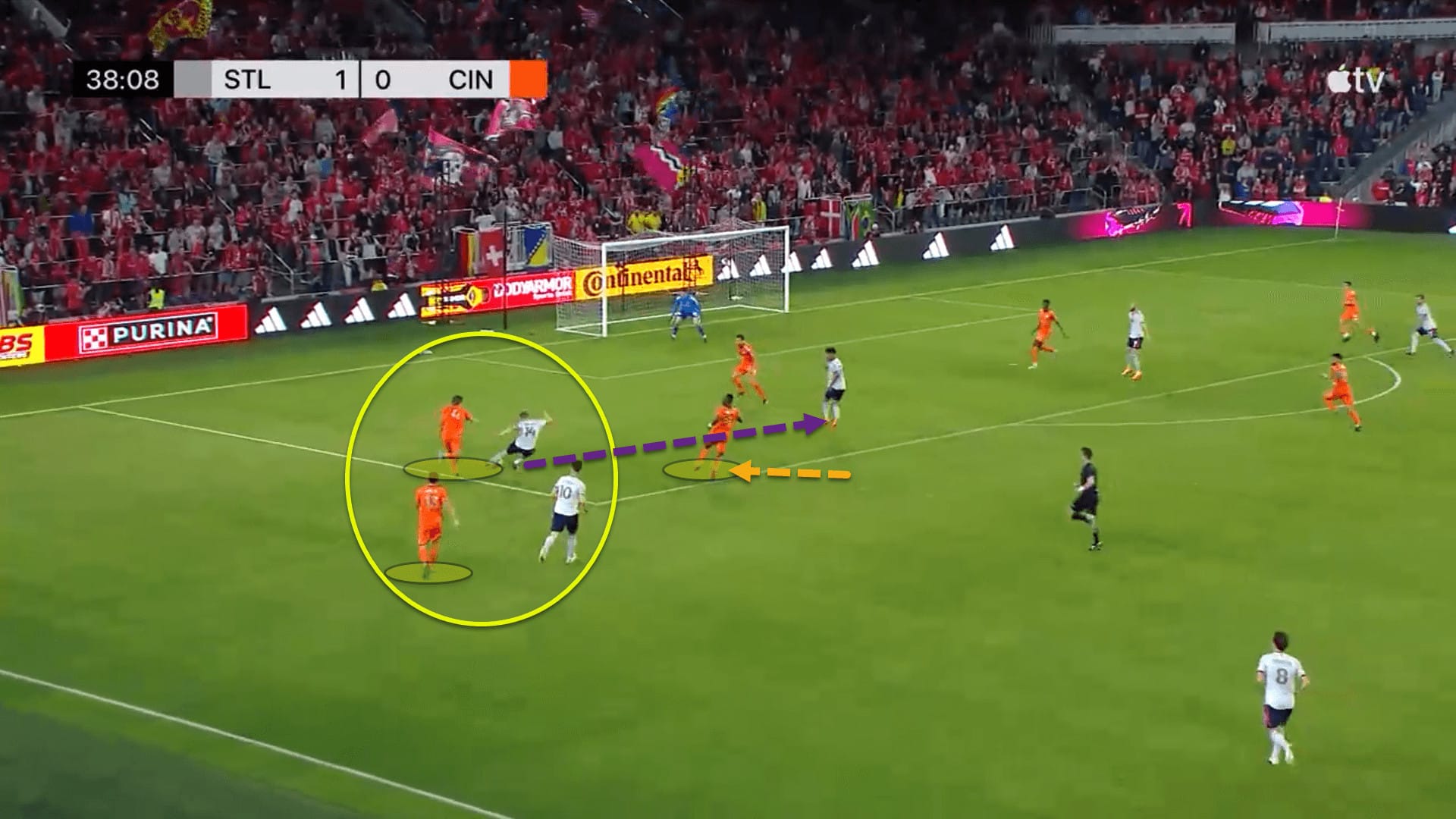
St. Louis City SC took advantage of this during Cincinnati’s ‘misery in Missouri’, 5-1 mauling taken at the hands of the new MLS club.
In the previous image, Cincinnati’s right wingback and right centre-back were beaten in a 2v2 battle against St. Louis City’s wide attackers. As a result, pivot player Obinna Nwobodo had to come across to try and make a last-ditch attempt to stop the cross, leaving the area at the edge of the box free. Since there was no adequate cover in this space, commonly known as ‘Zone 14’, the cross was played into the feet of the centre-forward Nicholas Gioacchini whose shot was blocked before Eduard Löwen placed it home to make it 2-0.
Having one of the forwards dropping back would have allowed Cincinnati to have a 3v2 on the flanks, avoiding the danger. This game was Cincinnati’s only defeat in MLS this season and was certainly a learning curve for Noonan and his players.
Direct play
Cincinnati are not necessarily a team that are going to carve you open with slick passing, nor are they a team that will build up through the thirds of the pitch consistently throughout a game. But they don’t need to be. There is more than one way of playing football.
Cincinnati have shown a willingness to play out from the back but also have an edge to them where direct balls to the forward line or to a runner in behind are the options taken.
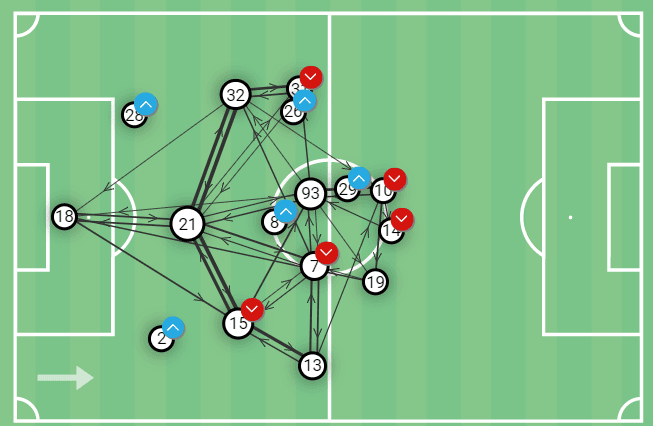
This is apparent in the goalkeeper’s links from a recent team passing network versus NYCFC. 22-year-old Roman Celentano is the man that Noonan trusts between the sticks. In this passing network, there are strong links from Celentano to all three central defenders but there are equally strong links to the midfield and forward line.
Sometimes a long ball over the opponent’s defence is the best way to progress the ball. The forward line are very smart and make channel runs to receive, knowing that the defenders will attempt to find them.
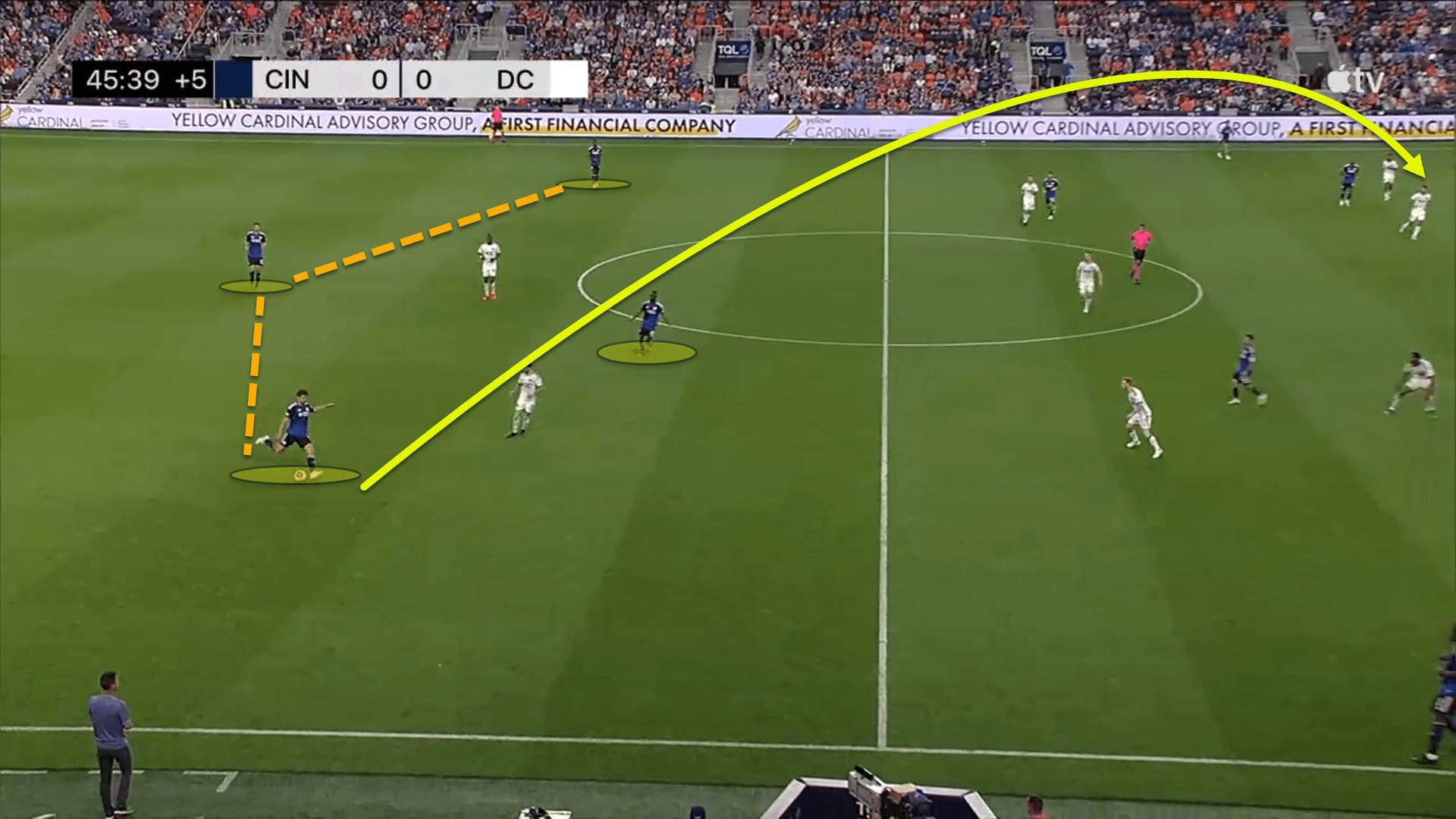
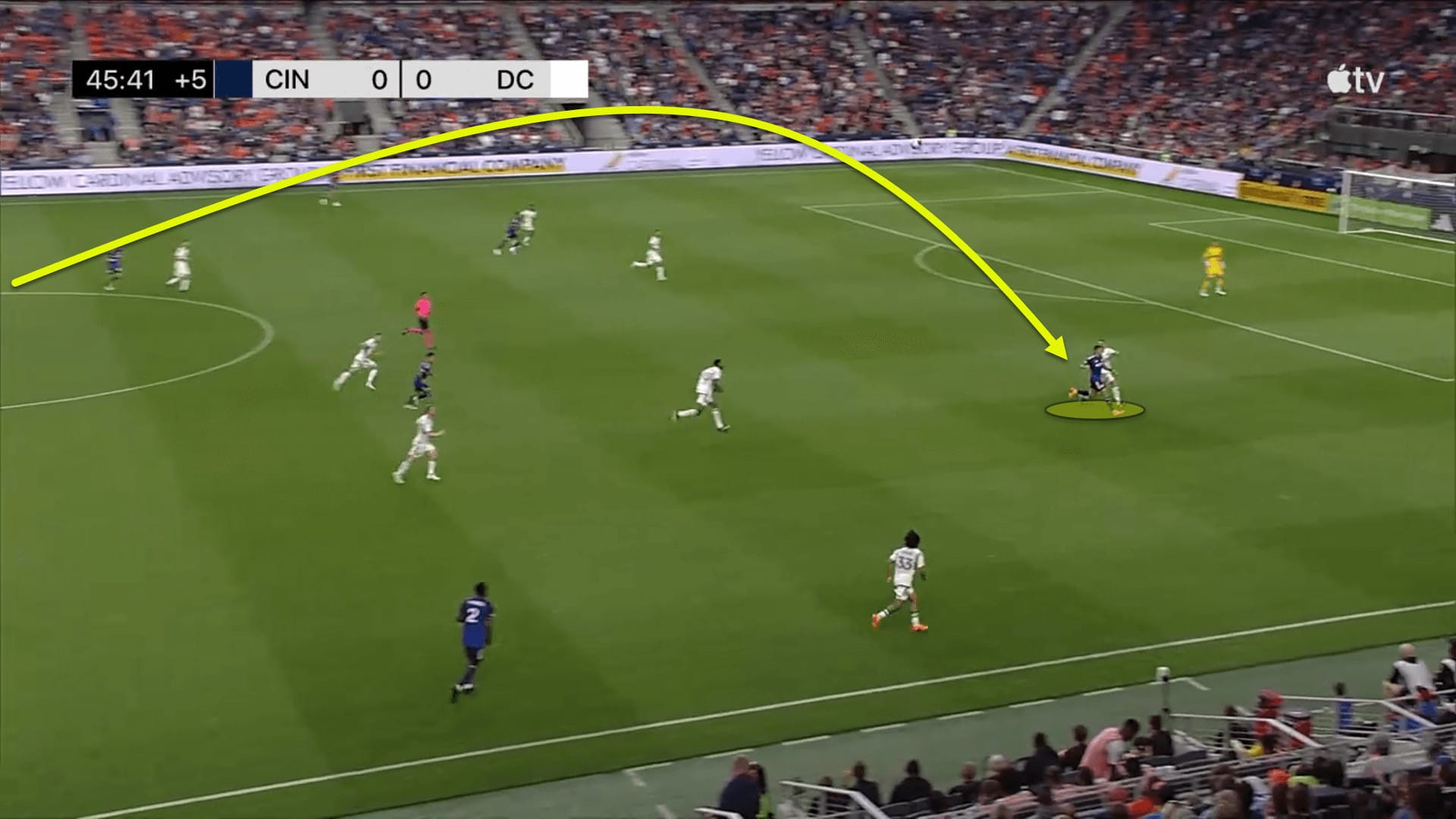
Here, DC United had done a great job of cutting off any obvious passing options for Cincinnati to keep play ticking. All players were marked tightly and the only other option was to go all the way back to the goalkeeper to restart the attack, inviting Wayne Rooney’s side to bring the lines up and put more pressure on them.
Instead, Nick Hagglund spotted the run of Vázquez who had isolated the central defender in a 1v1 duel. The USMNT international was able to trap the ball and hold it up to bring others into the fold. It was a fantastic ball by Hagglund and an even better spot of his teammate’s run but Noonan offers his players the license to play these types of passes to avoid situations where risky balls are being played through the centre of the pitch in an attempt to play ‘flashy football’.
Sometimes a good old-fashioned long ball is the best route for ball progression and Cincinnati certainly are no stranger to a direct pass over the top.
In 2023, Cincinnati have played 40 long balls per 90 in MLS, with an accuracy of 51.5 percent. Long balls are always going to have a low accuracy given the difficulty of successfully reaching a teammate from such a height but more than half on target is a pretty decent success rate.
Wingback runs and cut-back crosses
When we perform an analysis of Cincinnati’s possession statistics even further, Noonan’s side have averaged 3.85 passes per possession this season. In contrast, their opponents’ average is 4.36. Essentially, the Garys are playing less than four passes every time they receive the ball, proving how direct the Eastern Conference leaders can be at times.
We analysed channel balls that the defence play to the frontline in the previous section of this team scout report, but another one of Cincinnati’s primary methods to progress the ball is a pass in behind to an advancing wingback.
As Cincinnati’s front three stay very narrow between the lines, the wingbacks must get forward to provide width but Noonan also wants them to make runs in behind to stretch the opposition’s backline vertically and not just horizontally.
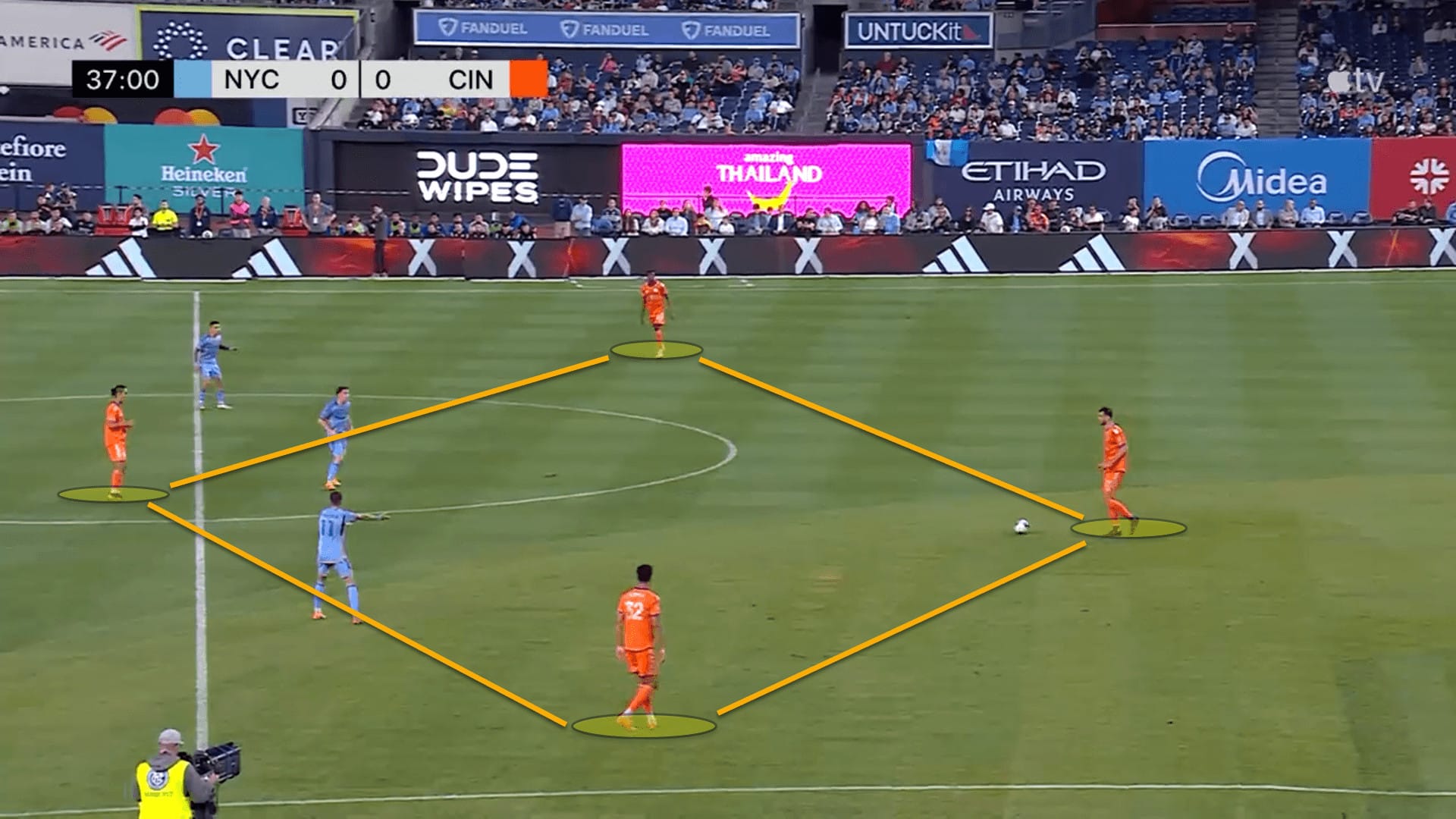
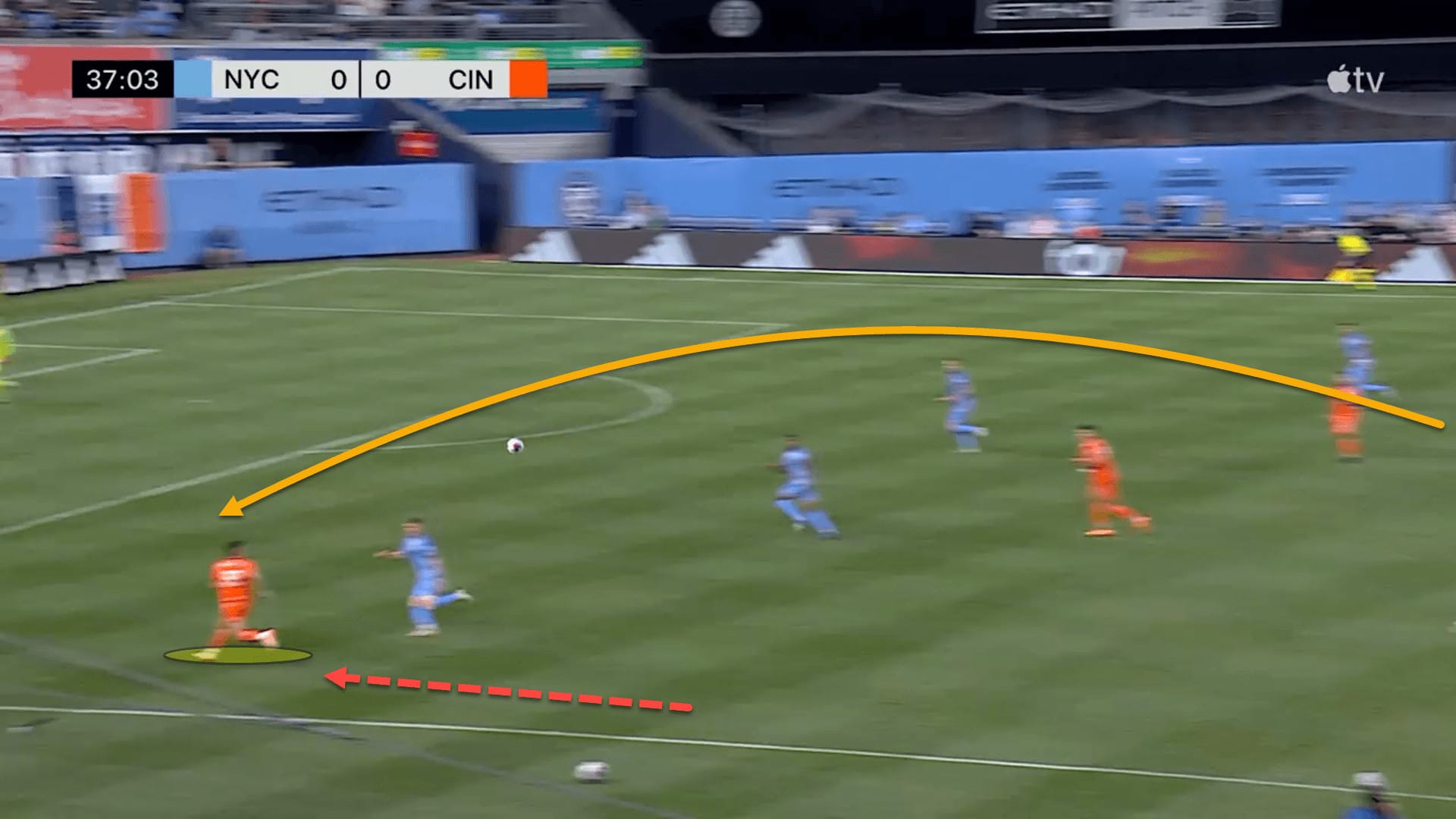
Here, the left wingback Barreal made a darting run in behind the NYCFC defender, latching on to a phenomenal long pass from former Chelsea defender Matt Miazga to get into a decent crossing position.
In these positions, there has been a trend that Cincinnati’s wingbacks cut the ball back across goal. The reason for this makes sense. As the player is running in behind, the opposition’s defence is dropping deeper and deeper to stay in line with the player and the ball. As the defenders drop deeper, the Cincinnati wingbacks cut it back, moving the ball in the opposite direction to the backline’s movement.
Paul McGuinness, a former guest of the TFA Podcast, calls this ‘opposite flow’.
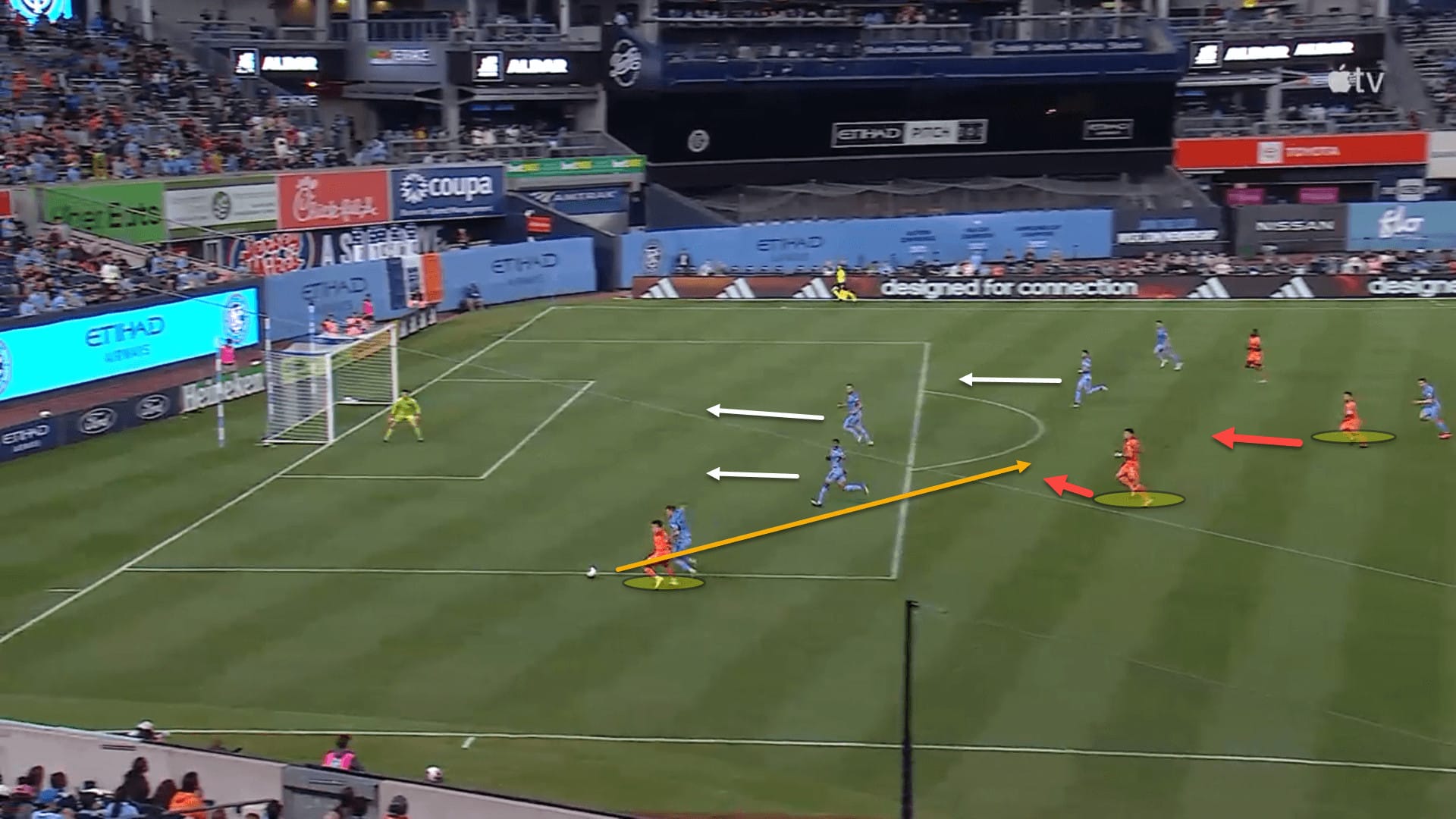
The Cincinnati players are actually struggling a little in front of goal. Only three teams in the Eastern Conference have scored more goals than Noonan’s side and four across both Conferences. However, the Ohio-based club are underperforming their xG in MLS.
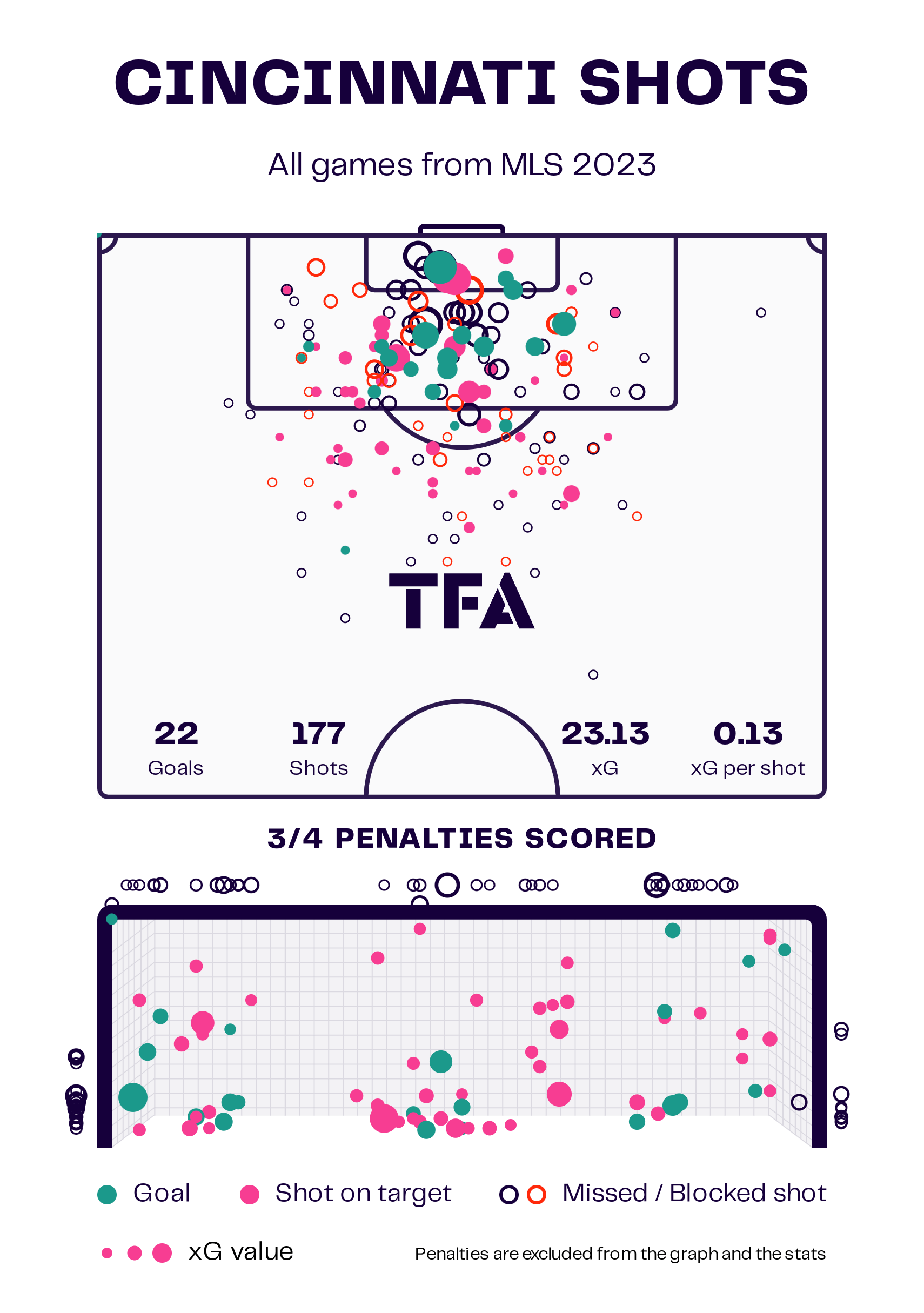
They currently hold a non-penalty xG of 23.13 but 22 real-time goals from non-penalty and non-OG situations. The loss of Brenner has not helped this as the young Brazilian joins Udinese at the start of July.
It is more so a case of poor finishing as opposed to a lack of chance creation. The opportunities are being crafted but the strikers are not taking them, as the expected assists map below shows.
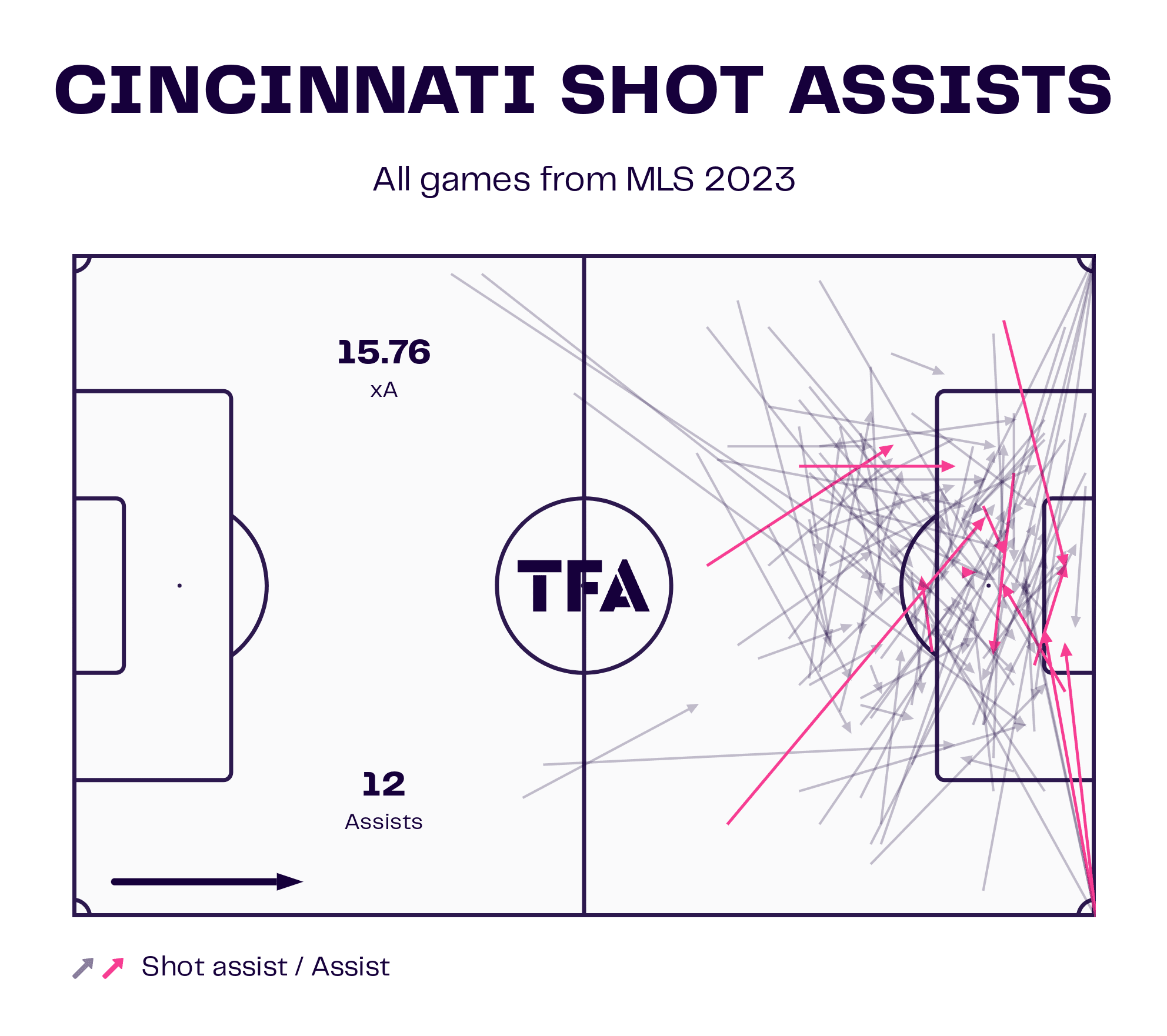
It must also be said that Cincinnati have won eight games this season across the US Open Cup and MLS by a score of 1-0, proving that defensive resiliency has been key to the side’s success thus far as opposed to attacking quality.
Conclusion
Given the lack of goalscoring prowess and quality in this team, Noonan has done incredibly well to get his players into a position where they look likely to win the Supporters’ Shield, but the absence of a potent number ‘9’ could hamper his men in their quest for the MLS Cup.
Nevertheless, a saving grace is that the transfer window is open very soon and so the recruitment team will need to work very closely with the head coach to decide who to bring in up front to give them the edge heading into the playoffs towards the back end of the current year. As things stand, the club are currently finalising a deal to sign Gabonese striker Aaron Boupendza from Saudi club Al-Shabab. Whether Boupendza will be the answer to Noonan’s goalscoring woes will only be revealed in due course.






Comments